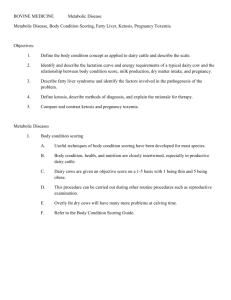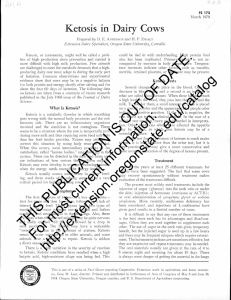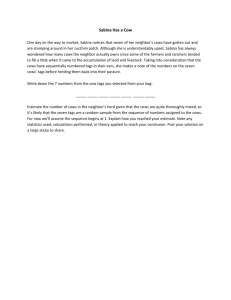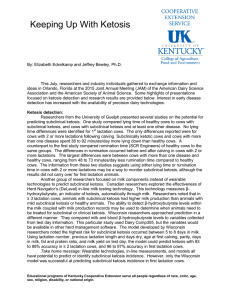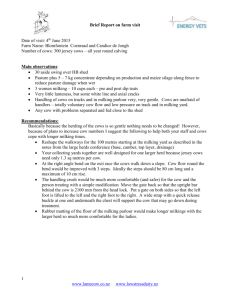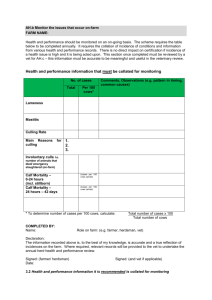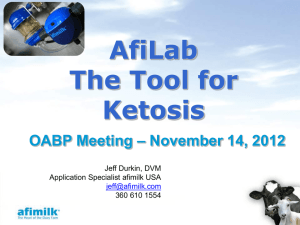- Midshire Farm and Equine
advertisement
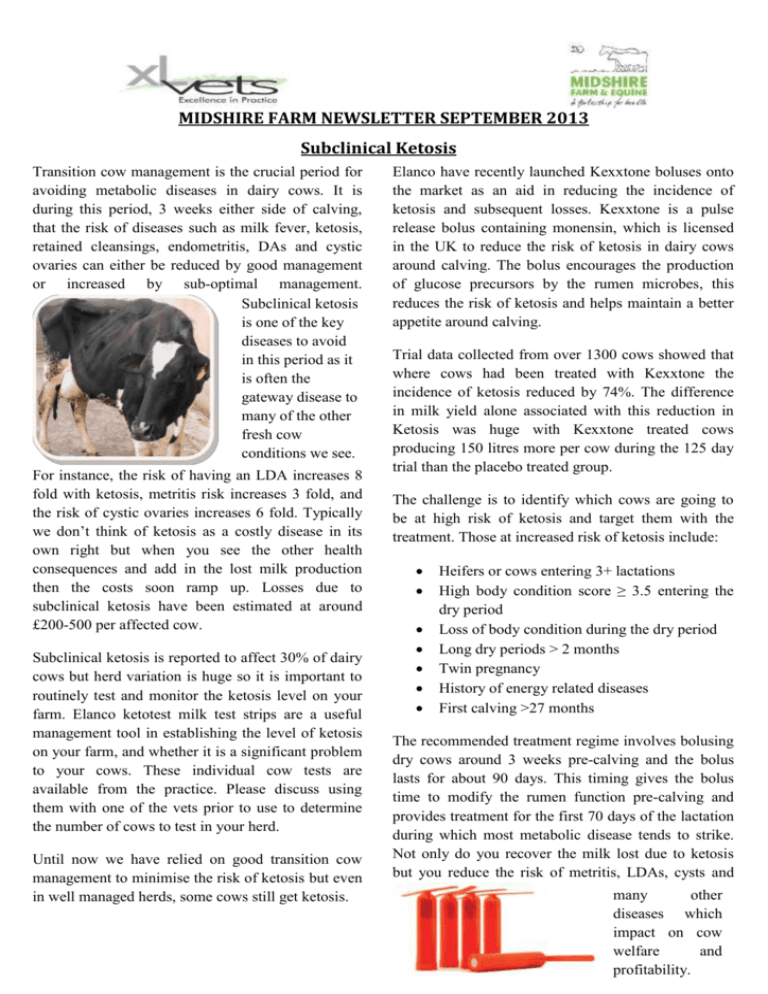
MIDSHIRE FARM NEWSLETTER SEPTEMBER 2013 Subclinical Ketosis Transition cow management is the crucial period for avoiding metabolic diseases in dairy cows. It is during this period, 3 weeks either side of calving, that the risk of diseases such as milk fever, ketosis, retained cleansings, endometritis, DAs and cystic ovaries can either be reduced by good management or increased by sub-optimal management. Subclinical ketosis is one of the key diseases to avoid in this period as it is often the gateway disease to many of the other fresh cow conditions we see. For instance, the risk of having an LDA increases 8 fold with ketosis, metritis risk increases increases 3 fold, and by 3 fold and the the risk of cystic ovaries increases 6 fold. Typically risk ofdisease cystic in its we don’t think of ketosis as a costly increases own right but when you see ovaries the other health by 6 fold. consequences and add in the lost milk production then the costs soon ramp up. Losses due to subclinical ketosis have been estimated at around £200-500 per affected cow. Subclinical ketosis is reported to affect 30% of dairy cows but herd variation is huge so it is important to routinely test and monitor the ketosis level on your farm. Elanco ketotest milk test strips are a useful management tool in establishing the level of ketosis on your farm, and whether it is a significant problem to your cows. These individual cow tests are available from the practice. Please discuss using them with one of the vets prior to use to determine the number of cows to test in your herd. Until now we have relied on good transition cow management to minimise the risk of ketosis but even in well managed herds, some cows still get ketosis. Elanco have recently launched Kexxtone boluses onto the market as an aid in reducing the incidence of ketosis and subsequent losses. Kexxtone is a pulse release bolus containing monensin, which is licensed in the UK to reduce the risk of ketosis in dairy cows around calving. The bolus encourages the production of glucose precursors by the rumen microbes, this reduces the risk of ketosis and helps maintain a better appetite around calving. Trial data collected from over 1300 cows showed that where cows had been treated with Kexxtone the incidence of ketosis reduced by 74%. The difference in milk yield alone associated with this reduction in Ketosis was huge with Kexxtone treated cows producing 150 litres more per cow during the 125 day trial than the placebo treated group. The challenge is to identify which cows are going to be at high risk of ketosis and target them with the treatment. Those at increased risk of ketosis include: Heifers or cows entering 3+ lactations High body condition score ≥ 3.5 entering the dry period Loss of body condition during the dry period Long dry periods > 2 months Twin pregnancy History of energy related diseases First calving >27 months The recommended treatment regime involves bolusing dry cows around 3 weeks pre-calving and the bolus lasts for about 90 days. This timing gives the bolus time to modify the rumen function pre-calving and provides treatment for the first 70 days of the lactation during which most metabolic disease tends to strike. Not only do you recover the milk lost due to ketosis but you reduce the risk of metritis, LDAs, cysts and many other diseases which impact on cow welfare and profitability. MIDSHIRE FARM NEWSLETTER SEPTEMBER 2013 Sheep Abortion Control. The majority of abortions and infertility that sheep flocks experience, are caused by two diseases: Enzootic abortion (EAE) and Toxoplasmosis. If you are experiencing an abortion rate of more than 1 in 50 ewes or have any worries about infertility, please contact us and arrange to have your flock tested. We recommend taking blood from 6-8 barren/aborted ewes that have not previously been vaccinated against either disease. The results of these blood tests will tell us whether EAE or Toxoplasmosis are active in your flock, and help us plan control by vaccination. If you get closer to lambing and start to experience abortions you can submit a fresh aborted foetus to the VLA at Sutton Bonnington for an abortion enquiry. If you do this please remember that it is very important to submit the afterbirth as well as the foetus so that testing for EAE can be carried out. Please contact the surgery before taking the foetus and afterbirth to the VLA, as relevant paperwork will have to be submitted by one of the vets prior to your arrival. This year, we will be recommending Enzovax as our EAE vaccine and Toxovax as our Toxoplasmosis vaccine. Both these vaccines need to be given before tupping (at least 4 weeks before for Enzovax, at least 3 weeks before for Toxovax). The good news is that they can now be given at the same time as long as different injection sites are used. Also this year don’t forget that Schmallenberg virus (SBV) was a major cause of infertility, abortions and lamb losses last winter and spring. We expect this disease to continue to cause problems each year now that it is established in England and therefore we would recommend that you consider SBV vaccination this year for your flock. Again, this vaccine needs to be given at least 4 weeks before tupping and a gap of 2 weeks needs to be elapse between this vaccine and any EAE or Toxoplasmosis vaccination.
